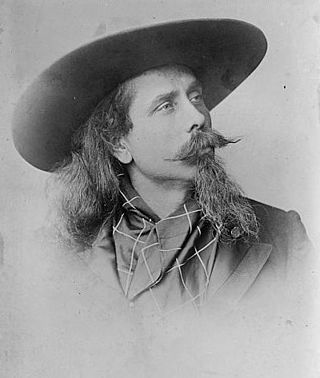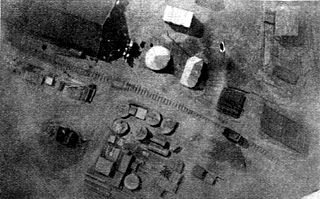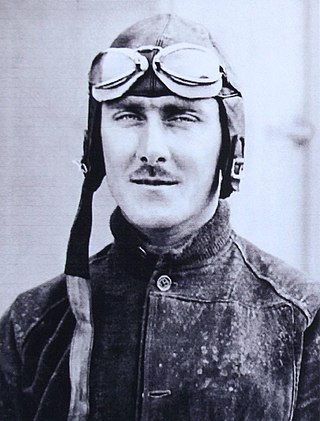
The Royal Flying Corps (RFC) was the air arm of the British Army before and during the First World War until it merged with the Royal Naval Air Service on 1 April 1918 to form the Royal Air Force. During the early part of the war, the RFC supported the British Army by artillery co-operation and photographic reconnaissance. This work gradually led RFC pilots into aerial battles with German pilots and later in the war included the strafing of enemy infantry and emplacements, the bombing of German military airfields and later the strategic bombing of German industrial and transport facilities.

Samuel Franklin Cowdery was a Wild West showman and early pioneer of manned flight.

The Royal Aircraft Factory B.E.2 is a British single-engine tractor two-seat biplane, designed and developed at the Royal Aircraft Factory. Most of the roughly 3,500 built were constructed under contract by private companies, including established aircraft manufacturers and firms new to aircraft construction.

This is a list of aviation-related events from 1912:
This is a list of aviation-related events from 1916:

The Deutsche Luftstreitkräfte —known before October 1916 as Die Fliegertruppen des deutschen Kaiserreiches —was the air arm of the Imperial German Army. In English-language sources it is usually referred to as the Imperial German Air Service, although that is not a literal translation of either name. German naval aviators of the Marine-Fliegerabteilung were an integral part of the Imperial German Navy. Both military branches operated aeroplanes, observation balloons and airships.

The Boxkite was the first aircraft produced by the British and Colonial Aeroplane Company. A pusher biplane based on the successful Farman III, it was one of the first aircraft types to be built in quantity. As the type was used by Bristol for instruction purposes at their flying schools at Larkhill and Brooklands many early British aviators learned to fly in a Boxkite. Four were purchased in 1911 by the War Office and examples were sold to Russia and Australia. It continued to be used for training purposes until after the outbreak of the First World War.

Air Commodore Edward Maitland Maitland, was an early military aviator who served in the Air Battalion of the Royal Engineers, the Royal Flying Corps, the Royal Naval Air Service and the Royal Air Force. He was a noted pioneer of lighter-than-air aviation.

Major-General Sir John Edward Capper was a senior officer of the British Army during the late nineteenth and early twentieth century who served on the North-West Frontier of British India, in South Africa and during the First World War, where he was instrumental in the development of the tank. He was the older brother of Major-General Thompson Capper, who was killed in action at the Battle of Loos in late 1915.

The School of Ballooning was a training and test centre for British Army experiments with balloons and airships. It was established at Chatham in Kent in 1888. The School moved to Stanhope Lines, Aldershot in 1890 when a balloon section and depot were formed as permanent units of the Royal Engineers establishment. The School was sometimes known as the Balloon Factory.

The Farnborough Air Sciences Trust (FAST) museum holds a collection of aircraft, satellites, simulators, wind tunnel and Royal Aircraft Establishment-related material. It is based in Farnborough, Hampshire immediately adjacent to Farnborough Airfield on the A325 Farnborough Road.
The following timeline of British military aviation covers the military aviation activities of the British Armed Forces from its origins in the 19th century to the present day:

The Italian Corpo Aeronautico Militare was formed as part of the Regio Esercito on 7 January 1915, incorporating the Aviators Flights Battalion (airplanes), the Specialists Battalion (airships) and the Ballonists Battalion. Prior to World War I, Italy had pioneered military aviation in the Italo-Turkish War during 1911–1912. Its army also contained one of the world's foremost theorists about the future of military aviation, Giulio Douhet; Douhet also had a practical side, as he was largely responsible for the development of Italy's Caproni bombers starting in 1913. Italy also had the advantage of a delayed entry into World War I, not starting the fight until 24 May 1915, but took no advantage of it so far as aviation was concerned.

Netheravon Airfield is a Ministry of Defence grass strip airfield on Salisbury Plain, in Wiltshire, England. Established in 1913 by the Royal Flying Corps, it became RAF Netheravon from 1918 until 1963, then AAC Netheravon until 2012. Buildings from 1913 and 1914 survive on part of the site. The site forms part of the Tidworth, Netheravon and Bulford (TidNBul) Garrison.

The Nieuport IV was a French-built sporting, training and reconnaissance monoplane of the early 1910s.
Alan Douglas Carden was a British pioneer aviator who rose to the rank of Colonel in the Royal Engineers. He gained his pilot's licence and served with the RFC in World War I, despite having only one hand.

Reginald Archibald Cammell was an early British military aviator and the first to be killed on active service.
















